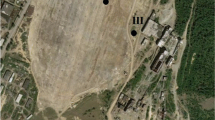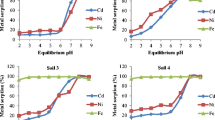Abstract
Desorption of Cu, Cr, Pb, and Zn from industrially polluted soils as a result of acidification is in focus. The eight soils of the investigation vary greatly in composition and heavy metal concentration/combination. Three soils had elevated concentrations of Cu, Pb, and Zn; regardless of pollution level, pollution origin, and soil type, the order for desorption as pH decreased was Zn > Cu > Pb. Turning to a single heavy metal in different soils, there was a huge difference in the pH at which the major desorption started. The variation was most significant for Pb where, e.g., less than 10% was desorbed at pH 2.5 from one soil, whereas in another soil 60% Pb was desorbed at this pH. Sequential extraction was made and the soils in which a high percentage of Pb was found in the residual phase (adsorbed strongest) was also the soils where less Pb was desorbed at low pH in the desorption experiments. It was evident that Cu, Pb, and Zn started to desorb at a higher pH from calcareous soils than from soils with low carbonate content. The mechanism responsible for this is co-precipitation of heavy metals in the carbonates. When the carbonates are dissolved at a relatively high pH of about 5, the co-precipitated heavy metals are released. The sequential extraction pattern for Cr differed generally much from the other heavy metals since the majority of Cr was extracted in the last two steps. Cr was also the heavy metal that desorbed the least at high acidification.




Similar content being viewed by others
References
Alloway, B. J. (1995). Soil processes and the behaviour of heavy metals. In B. J. Alloway (Ed.), Heavy metals in soils. London: Blackie Academic & Professional.
Covelo, E. F., Vega, F. A., & Andrade, M. L. (2007). Competitive sorption and desorption of heavy metals by individual soil components. Journal of Hazardous Materials, 140, 308–315. doi:10.1016/j.jhazmat.2006.09.018.
De Vries, W., Posch, M., & Kämäri, J. (1989). Simulation of the long-term soil response to acid deposition in various buffer ranges. Water, Air, and Soil Pollution, 48(3–4), 349–390. doi:10.1007/BF00283336.
Dohrmann, R. (2006). Cation exchange capacity methodology I: an efficient model for the detection of incorrect cation exchange capacity and exchangeable cation results. Applied Clay Science, 34, 31–37. doi:10.1016/j.clay.2005.12.006.
García-Delgado, R. A., García-Herruzo, F., Rodríguez-Maroro, J. M., & Vereda, C. (1996). Influence of soil carbonates in lead fixation. Journal of Environmental Science and Health. Part A, Environmental Science and Engineering & Toxic and Hazardous Substance Control, 31(9), 2099–2109.
Jensen, P. E., Ottosen, L. M., & Pedersen, A. J. (2006). Speciation of Pb in industrially polluted soils. Water, Air, and Soil Pollution, 170, 359–382. doi:10.1007/s11270-005-9008-7.
Kliem, B. K., & Hansen, L. (2000). Electrodialytic soil remediation in a small pilot plant (Part II). Extractions, IR, XRD, TEM and SEM investigations on untreated and EDR-treated Cu-polluted soil. In: B. K. Kliem, Bonding of heavy metals in soil, Ph.D. thesis, Technical University of Denmark, August 2000.
Köleli, N. (2004). Speciation of chromium in 12 agricultural soils from Turkey. Chemosphere, 57, 1473–1478. doi:10.1016/j.chemosphere.2004.08.068.
Lock, K., & Janssen, C. R. (2003). Influence of ageing on zinc bioavailability in soils. Environmental Pollution, 126, 371–374. doi:10.1016/S0269-7491(03)00232-X.
Loeppert, R.H., Suarez, D.L. (1995) Methods of Soil Analysis. Part 3. Chemical Methods—SSSA Book series No. 5, 451–455.
Lund, U., & Fobian, A. (1991). Pollution of two soils by arsenic, chromium and copper, Denmark. Geoderma, 49, 83–103. doi:10.1016/0016-7061(91)90093-9.
Madrid, L., & Diaz-Barrientos, E. (1992). Influence of carbonate on the reaction of heavy metals in soils. Journal of Soil Science, 43, 709–721.
Markiewicz-Patkowska, J., Hursthouse, A., & Przybyla-Kij, H. (2005). The interaction of heavy metals with urban soils: sorption behaviour of Cd, Cu, Cr, Pb and Zn with a typical mixed brownfield deposit. Environment International, 31, 513–521. doi:10.1016/j.envint.2004.09.004.
Martínez, C. E., & Motto, H. L. (2000). Solubility of lead, zinc and copper added to mineral soils. Environmental Pollution, 107, 153–158. doi:10.1016/S0269-7491(99)00111-6.
Mesquita, M. E., & Carranca, C. (2005). Effect of dissolved organic matter on copper zinc competitive adsorption by a sandy soil at different pH values. Environmental Technology, 26(9), 1065–1072. doi:10.1080/09593332608618493.
Mester, Z., Cremisini, C., Ghiara, E., & Morabito, R. (1998). comparison of two sequential extraction procedures for metal fractionation in sediment samples. Analytica Chimica Acta, 359, 133–142. doi:10.1016/S0003-2670(97)00687-9.
Miljøstyrelsen (2003). Liste over kvalitetskriterier i relation til forurenet jord (A list of quality criteria in relation to polluted soil) In Danish.
Ottosen, L. M., Hansen, H. K., Ribeiro, A. B., & Villumsen, A. (2001). Removal of Cu, Pb and Zn in an applied electric field in calcareous and non-calcareous soils. Journal of Hazardous Materials, B85, 291–299. doi:10.1016/S0304-3894(01)00231-X.
Ottosen, L. M., Kubal, M., & Lepkova, K. (2006). Comparison of electrodialytic removal of Cu from spiked kaolinite, spiked soil and industrially polluted soil. Journal of Hazardous Materials, 137(1), 113–120. doi:10.1016/j.jhazmat.2005.04.044.
Saeed, M., & Fox, R. L. (1977). Relations between suspension pH and Zn solubility in acid and calcareous soils. Soil Science, 124, 199–204. doi:10.1097/00010694-197710000-00002.
Schnitzer, M., & Kerndorff, H. (1980). Effects of pollution on humic substances. Environ Sci Health B, 15(4), 431–456.
Zhang, P., Ryan, J. R., & Yang, J. (1998). In Vitro soil Pb solubility in the presence of hydroxyapatite. Environmental Science & Technology, 32, 2763–2768.
Author information
Authors and Affiliations
Corresponding author
Rights and permissions
About this article
Cite this article
Ottosen, L.M., Hansen, H.K. & Jensen, P.E. Relation Between pH and Desorption of Cu, Cr, Zn, and Pb from Industrially Polluted Soils. Water Air Soil Pollut 201, 295–304 (2009). https://doi.org/10.1007/s11270-008-9945-z
Received:
Accepted:
Published:
Issue Date:
DOI: https://doi.org/10.1007/s11270-008-9945-z




